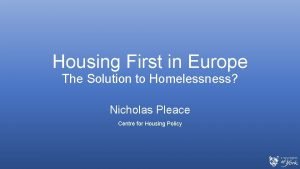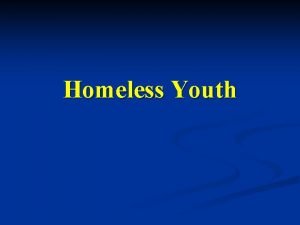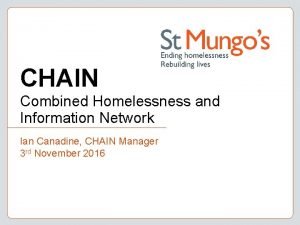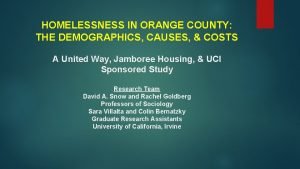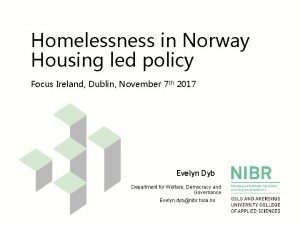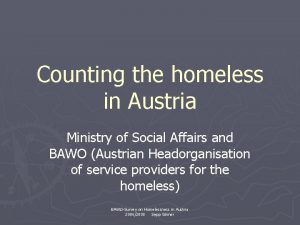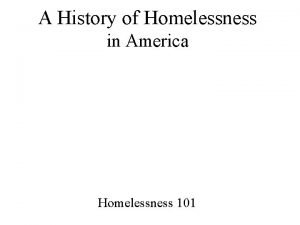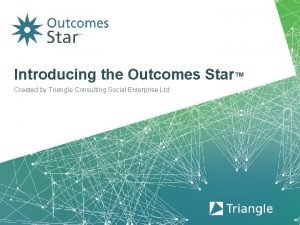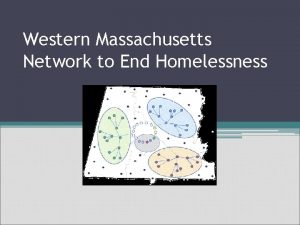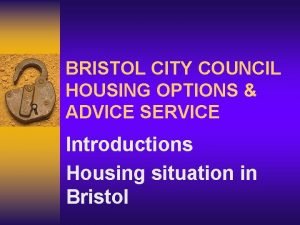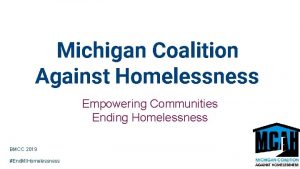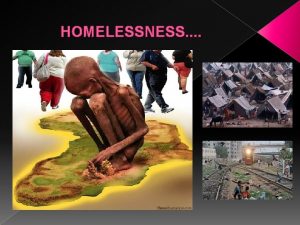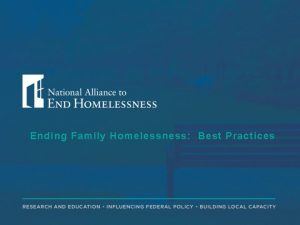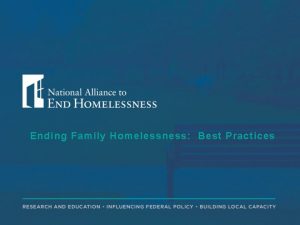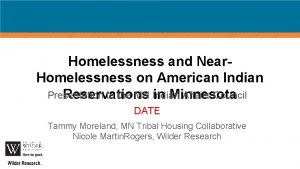Setting a Path to Ending Family Homelessness Presentation
















- Slides: 16

Setting a Path to Ending Family Homelessness Presentation to the Early Childhood Cabinet July 30, 2015 Lisa Tepper Bates, CCEH Executive Director Think Change • Be Change • Lead Change

HEARTH ACT In 2009, President Obama signed the Homeless Emergency Assistance and Rapid Transition to Housing (HEARTH) Act of 2009 requiring communities to work in new ways to end homelessness. HEARTH Goals: • No one is homeless longer than 30 days • Reduce new episodes of homelessness • Reduce return entries into homelessness Think Change • Be Change • Lead Change

Opening Doors-CT The federal plan to end homelessness further to the HEARTH Act is “Opening Doors” – unites federal efforts across agencies, programs • “Opening Doors-CT” = state strategy aligned with Federal Plan • Comprehensive approach promotes connections between sectors o • Including housing, healthcare, employment, education, criminal justice, behavioral health and child welfare systems Emphasizes collaboration among non-profits and community leaders, state government agencies, philanthropy, business and others Think Change • Be Change • Lead Change

Opening Doors-CT Goals • End homelessness among Veterans by 2015 • Finish the job of ending chronic homelessness (long-term homelessness of people with disabilities) by 2016 • Prevent and end homelessness among families, youth and children by 2022 • Set a path to ending all types of homelessness Think Change • Be Change • Lead Change

Defining an end to homelessness � What it does not mean: that no one will ever experience a housing crisis again � What it does mean: that every community will have a systematic response to ensure that homelessness is rare, brief, and non-recurring Think Change • Be Change • Lead Change

How many families and children experience homelessness in Connecticut? • 1, 345 Families were homeless in Connecticut in 2014 • 26% headed by someone under the age of 25 • 44% headed by someone 25 to 34 • 2, 440 Children were part of these homeless families • Nearly 90% of homeless children in Connecticut are under 12 years old • 47% under the age of 5 • 40% between 5 and 12 Think Change • Be Change • Lead Change

Coordinated access The HEARTH Act requires new approaches to prevent and reduce homelessness • “Coordinated Access, ” the coordination of all resources and programs in a community that address homelessness – central HEARTH element • Coordination of resources from front-door of homeless system through exit to housing Think Change • Be Change • Lead Change

Core principles of coordinated access • Accessible: Easier access for people in housing crisis to the resources they need • Standardized: Implemented consistently across the coordinated access network • Comprehensive: Access, assessment, and assignment to services for homeless households • Accountable: Partners maximize impact of resources, meet needs of each client family with appropriate resources Think Change • Be Change • Lead Change

Systems Change Increased coordination = better housing results Without CA With CA Source: Home For Good, 2014 Think Change • Be Change • Lead Change

What Works to End Family Homelessness? • HUD commissioned a three-year, national study to track the impact of different interventions • Subsidized housing: highest impact in improving housing stability o CT has a gap of 100, 000 units of deeply affordable housing • Rapid Re-housing: crisis-response intervention of best housing stability impact and best cost effectiveness Think Change • Be Change • Lead Change

Rapid Re-housing • Housing-focused case management, housing location, and short-term assistance to achieve stability • Reduces length of shelter stays – frees up crisis beds for others in need • Reduces the negative impacts of long-term homelessness • Research reflects positive impact on housing stability o Compared with homeless households that do not receive rapid re- housing o Positive impact equal to more expensive interventions short of permanent subsidy Think Change • Be Change • Lead Change

Cost per family per stay in intervention Source: Family Options Study, 2015 Think Change • Be Change • Lead Change

Resources to Expand Rapid Re-Housing? • Re-allocation of current HUD funding for homelessness • HUD Emergency Solutions Grants (ESG) • HOME Tenant Based Rental Assistance (TBRA) • TANF for rental assistance (highly successful Salt Lake City, Utah program) Think Change • Be Change • Lead Change

Improving Mainstream Resource Connections • Helping families exit homelessness to appropriate housing is essential – but only one element in achieving better family outcomes • Family Options Study: housing interventions primarily impact housing stability • How do we enhance mainstream connections to meet other critical child and family needs? Think Change • Be Change • Lead Change

Secure Jobs CT Two-year demonstration pilot to increase income of families transitioning from homelessness to housing • Connect participating families to education, training and supports they need to secure and maintain stable, competitive employment • Better integration and coordination of homeless services, workforce, child care sectors to effectively serve up to 150 families in DOH’s Connecticut’s Rapid Re-housing Program (CT-RRP) • Melville Charitable Trust leadership – 27 foundations across the state partnering with Department of Housing Think Change • Be Change • Lead Change

Questions? www. cceh. org Lisa Tepper Bates ltbates@cceh. org Think Change • Be Change • Lead Change
 A straight path that has a beginning and an ending
A straight path that has a beginning and an ending Finland homelessness solution
Finland homelessness solution Homelessness
Homelessness Definition of youth homelessness
Definition of youth homelessness Chain homelessness
Chain homelessness Michigan campaign to end homelessness
Michigan campaign to end homelessness Abolish homelessness
Abolish homelessness Causes of homelessness orange county
Causes of homelessness orange county Homelessness in norway
Homelessness in norway Homelessness in austria
Homelessness in austria Timeline of homelessness in america
Timeline of homelessness in america Definition of youth homelessness
Definition of youth homelessness The bill homelessness was
The bill homelessness was Outcome star
Outcome star Western mass network to end homelessness
Western mass network to end homelessness Homelessness prevention team bristol
Homelessness prevention team bristol Unity signalr
Unity signalr

